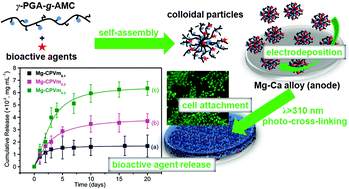Controlled release and corrosion protection by self-assembled colloidal particles electrodeposited onto magnesium alloys†
Abstract
We report a potential example of using surface functionalization to provide magnesium alloys (Mg–Ca) with controlled release and corrosion resistance properties. A key feature of this approach is to treat the Mg–Ca surfaces with nanoparticles via electrodeposition that can stably load and controllably release bioactive agents or drugs. These photo-cross-linkable and nano-scale particles were prepared by the self-assembly of an amphiphilic poly(γ-glutamic acid)-g-7-amino-4-methylcoumarin (γ-PGA-g-AMC) with encapsulation of a vitamin; moreover, the size and morphology of the resulting particles were studied. Fluorescence microscopy analysis indicated that Vm was effectively incorporated into the γ-PGA-g-AMC particles. Scanning electron microscopy (SEM) images showed that the colloidal particles could be uniformly electrodeposited on the Mg–Ca alloys. Fourier transform infrared spectroscopy (FTIR) and X-ray diffraction (XRD) analyses confirmed the successful anchoring of the particles. After the surface electrodeposition of self-assembled colloidal particles, the in vitro degradation results show that deposition of the particles was found to reduce the degradation rate of the magnesium alloys; moreover, the vitamin was controllably released for up to 20 days. Furthermore, the Mg–Ca substrate functionalized with colloidal particles containing a vitamin significantly promoted the attachment, proliferation and spread of NIH-3T3 normal cells. The entire strategy may be used in various medical devices to create coatings for improved biomedical performance.


 Please wait while we load your content...
Please wait while we load your content...